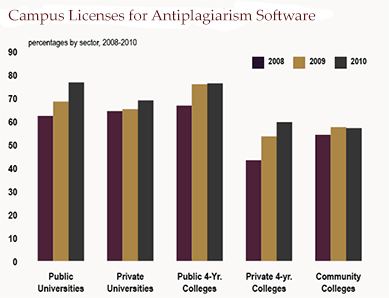Turnitin: Millions Served
 The specter of Internet plagiarism propels further interest in technologies that purport to solve the issue. Despite budget cutbacks in higher education across the U.S. today, demand for plagiarism detection technologies continues to rise. The bar graph to the left shows that, according to a 2010 survey of 523 U.S. institutions of higher education, campus licenses for plagiarism detection services jumped from approximately sixty percent of institutions surveyed in 2008 to nearly eighty percent in 2010 for public universities and colleges; private institutions and community colleges showed similar increases (Green, 2010, p. 17). Despite repeated critiques of Turnitin.com's services, many institutions have bought into the seductive sway of iParadigms, LLC's marketing messages.
The specter of Internet plagiarism propels further interest in technologies that purport to solve the issue. Despite budget cutbacks in higher education across the U.S. today, demand for plagiarism detection technologies continues to rise. The bar graph to the left shows that, according to a 2010 survey of 523 U.S. institutions of higher education, campus licenses for plagiarism detection services jumped from approximately sixty percent of institutions surveyed in 2008 to nearly eighty percent in 2010 for public universities and colleges; private institutions and community colleges showed similar increases (Green, 2010, p. 17). Despite repeated critiques of Turnitin.com's services, many institutions have bought into the seductive sway of iParadigms, LLC's marketing messages.
These messages have responded strategically to critiques of Turnitin's legal, ethical, and pedagogical features, often just enough to show that the company is ”listening” to its customers; however, iParadigms' response illustrates that it changes its practices at a surface level, ignoring deeper issues such as policing and punitive nature of Turnitin. For example, Barrie has responded to criticisms of Turnitin.com that attacked its policy of harvesting all uploaded works for its centralized database by creating yet another service of iParadigms, LLC: WriteCheck.com. WriteCheck specifically targets anxious students worried that their papers won't pass muster with Turnitin.com; for only $7.95 per 5,000 word paper, students can check their paper for originality prior to it being checked by Turnitin. They can include up to three revisions of their paper as well, allowing them to test whether their work would pass an originality check at Turnitin and to continue revising it until it does so. Most interestingly in light of Turnitin's massive databases, students pay for the privilege of not having their writing stored in Turnitin’s databases—WriteCheck does not store any of the material submitted.
With the number of schools that have subscribed to Turnitin’s services and with the additional revenue brought in by their WriteCheck for Students program, Turnitin likely garners multiple millions of dollars in revenue per year. Turnitin’s near-monopolization of the market and its proprietary database have helped propel it to levels of saturation in higher education that few, if any, other plagiarism detection services can achieve. Barrie boasted in 2001 that “in very short order … we’ll have it all wrapped up. We’ll become the next generation’s spell checker. … There will be no room for anybody else, not even a Microsoft, to provide a similar type of service because we will have the database” (as cited in Masur 2001).

Along with market saturation amidst fears of Internet plagiarism run amok, there must be another reason for the continued use of Turnitin.com. As well as plying our fears, the company has effectively crafted multiple messages that reveal a savvy rhetorical awareness. When we buy into these messages, what exactly are we committing to? Andrea Lunsford (1996) stated that our attitudes toward intellectual property help us assign value to products and their producers (p. 270). We can see this connection clearly in our responses to Turnitin.com and its attendant suite of products vying for our attention—GradeMark, PeerMark, WriteCheck, iThenticate—all of which demand our monetary investment in return for their “value,” which Turnitin describes as a host of affordances ranging from saving time, to offering better feedback for students, to alleviating anxieties about originality in students’ work. In exchange for satisfying these demands, all iParadigms asks is complete control over the intellectual property contained within its databases, or for your monetary donation to ensure your work escapes iParadigms' databases (at least for a little while).
index ![]()
![]() the specter of internet plagiarism
the specter of internet plagiarism ![]()
![]() the turn to turnitin.com page 1
the turn to turnitin.com page 1 ![]() page 2
page 2 ![]() page 3
page 3 ![]() page 4
page 4 ![]() page 5
page 5 ![]() page 6
page 6 ![]()
![]() authorship and anxiety page 1
authorship and anxiety page 1 ![]() page 2
page 2 ![]() page 3
page 3 ![]() page 4
page 4 ![]() page 5
page 5 ![]() page 6
page 6 ![]()
![]() critical assessment
critical assessment ![]()
![]() references
references

